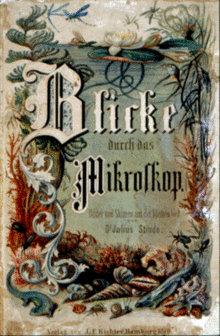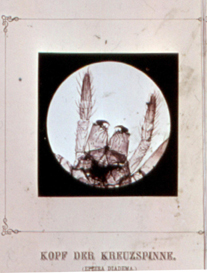Look through the microscope
Views through the microscope is a book by the German author Julius Stinde , which was published in deliveries from 1868 to 1870 by JF Richter in Hamburg. It contains twelve photographic prints from the negative, which are glued to cardboard. The book is recorded in three German libraries, in the Schleswig-Holstein State Library in Kiel , in the library of the German Museum in Munich and the library of the Rheinisch-Westfälische Technische Hochschule in Aachen. The first book of this kind was the 'Atlas der Allgemeine thierischen Gewebelehre: Ed. By Theodor von Hessling and Julius Kollmann (1834–1918); Photographed from nature by Joseph Albert, published in 1862, in Leipzig by Wilhelm Engelmann with 28 almost full-page microphotographs.
content
The book covers a wide range of scientific topics. The microphotographs are often only the occasion to present the findings of the natural sciences of the 19th century with an instructive gesture. After the introduction, it contains a chapter on the subjects of "The natural sciences", "The housefly", "A drop of water (The world of diatoms)", "The spider", "A snail's tongue", "Anchors and plates of the sea roller" and "Aus plant life ”. The book is aimed at a lay audience, but the then publisher JF Richter seems to have high hopes for the book's commercial success. He writes in the foreword: “We therefore attach the company to everyone who is serious about spreading scientific education and who want to see the wonders of the microscope spread to all classes and castes of human society. It should be particularly recommended to parents and educators as a house and family book; for teachers as a good teaching tool ; An instructive, entertaining reading for science researchers and thinking laypeople, and the artist himself should welcome it as a step forward in photography with regard to images. ”The microphotographs show the following motifs: foot of the fly; Fly proboscis; Great three horn; Ray disc; Foot of the labyrinth spider; Head of the garden spider; Agate pond snail tongue; Anchors and plates of a sea roller; Rush marrow; Spruce wood (cross section); Spruce wood (radial section); Stamen of the water lily.
Emergence
Stinde reports on the genesis of the book in his autobiographical essay:
"Often occupied with microscopic work, I published a work" Views through the microscope "in Richter's publishing house, which was illustrated by a number of microscopic photographs, the making of which gave me all the more difficulties when I had to orient myself towards the sun, but this one With the cloudy Hamburg sky, I didn't care about my free time. The same results are easy to achieve today with the latest tools, but back then some of my recordings aroused even Helmholtz's interest. The publisher did bad business with the book, the price of which had turned out to be relatively high due to the furnishings, and since no feeling is more embarrassing for the author than the dull belief that he had cut his publisher's costs, it was a real relief to me, when the proposal was made to carry out an idea of the publisher that would probably be able to make up for that loss to some extent. ""
This “publisher's idea” is about the work Water and Soap , which appeared at about the same time as looking through the microscope .
Individual evidence
- ^ Ulrich Goerdten: Bibliography Julius Stinde. Aisthesis, Bielefeld 2001, No. 3, p. 9
- ↑ Karlsruhe Virtual Catalog
- ↑ Julius Stinde: Look through the microscope . Richter, Hamburg 1870, foreword by the publisher, p. 2.
- ↑ Julius Stinde: "How I made the acquaintance of Frau Wilhelmine Buchholz". In: Julius Stinde 1841–1905 . Anniversary font for the 150th birthday. Compiled by Ulrich Goerdten. Volkshochschule, Lensahn 1991, pp. 50–62, here pp. 51f.
Web links
- Look through the microscope ( Memento from June 6, 2011 in the web archive archive.today )

